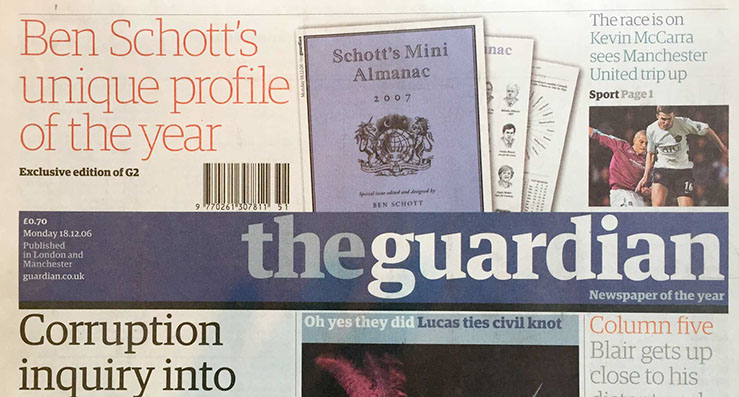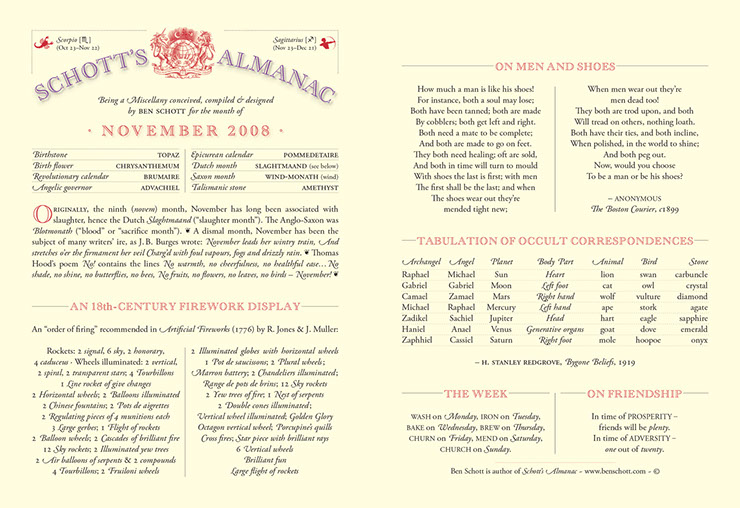
For 116 weeks, between January 2003 and March 2005, I produced an exclusive
Miscellany column for the ‘Weekend’ section of the Saturday Daily Telegraph.
Below are some samples from this series (the archive of which is not online).










![]()
![]()

The Guardian serialized the first two editions of the British Almanac
– devoting the cover of G2 and ten inside pages to the book.

Having taken photographs for Reader’s Digest in the past, including a cover portrait of
Tony Blair, it was a pleasure later to be asked to write for the magazine. I created two columns for the Digest, the first (2008–2009) was an Almanac relevant to each month; the second (2010–2011) was a series of ‘Snap Schotts’ featuring a newsy statistical nugget.


Between November 2008 and June 2011, I edited the daily language blog
Schott’s Vocab for the Op-Ed pages of The New York Times.
The site was intended to be a repository of unconsidered lexicographical trifles — some serious, others frivolous, some neologized, others newly newsworthy. Each day, Schott’s Vocab explored news sites around the world to find words and phrases that encapsulate the times in which we live or shed light on a story of note. If language is the archives of history, as Emerson believed, then Schott’s Vocab was an attempt to index those archives on the fly.
(The archives of Schott’s Vocab are online here.)
In addition to its quotidian quota of new words, the blog
also featured a number of fascinating guest blogs, including
Robert Lane Greene
James Geary
David Crystal
Schott’s Vocab was also delighted to extract gems from the American Speech – “a quarterly of linguistic usage” – published on behalf of the American Dialect Society. These included:
Jargon of Fistonia (1933) · The Lingo of the Shoe Salesman (1934)
A Caddy’s Companion (1937) · Hotel Slang (1939)
One highlight of the Vocab blog was its weekend competitions, where co-vocabularists
(i.e., readers) offered their wisdom and wit in response to a series of challenges.
Of the many competitions held, these are a few favorites:
Nifty Ways to Leave Your Lover
and the ever-popular

After ink on paper, radio is my favorite medium – and it is an ideal fit for Miscellany.
Below are some of the radio pieces I have written and presented for Radio 4.
The Art of the Menu
September 2014 · Produced by Tamsin Hughes
“Ben Schott examines the graphic and gastronomic tricks of the menu.
With The Homestead Inn's Giacomo and Peter Rosati; Birmingham-born, Manhattan-based chef April Bloomfield; The New York Public Library's Rebecca Federman who co-curates What's On The Menu?; graphic designer and menu sumpremo Matteo Bologna; Kate Krader, Restaurant Editor at Food and Wine magazine; and Eisenbergs lunch counter regular Mark Kirschner.”
Almanacs: The Oldest Guide to Everything
July 2010
produced by Tamsin Hughes
“At their height, apart from the bible, almanacs were the bestselling books on the market, with over 400,000 sold annually … Combining the characteristics of calendar, self-help manual & pocket encyclopaedia, almanacs contained utilitarian information on just about everything: feast days, when to sow crops, let blood, how to write an IOU, even advice on amateur surgery and DIY abortion. They also included dramatic astrological prophesies about the likelihood of plague, famine and war. Passages were read to boost soldiers’ morale in battle and by MPs in the House of Commons.”
Oulipo
November 2009 · Produced by Bob Dickinson
“Founded in 1960 and still in existence, Oulipo create work by imposing playful restrictions the way a text will be produced. Oulipo stands for Ouvroir de Litterature Potentielle, meaning Workshop for Potential Literature. In this humourous history of the French literary group, Ben discovers that recently, Oulipo have even made a bridgehead into English-speaking territory.”
The Rise of the Footnote
April 2008 · Produced by Nicola Barranger
“A light-hearted look at the history of the footnote in western literature, from the scribbled notes in the margin of a manuscript to multi-layered systems such as Wikipedia, an online environment where any piece of text can be a footnote to any other.”